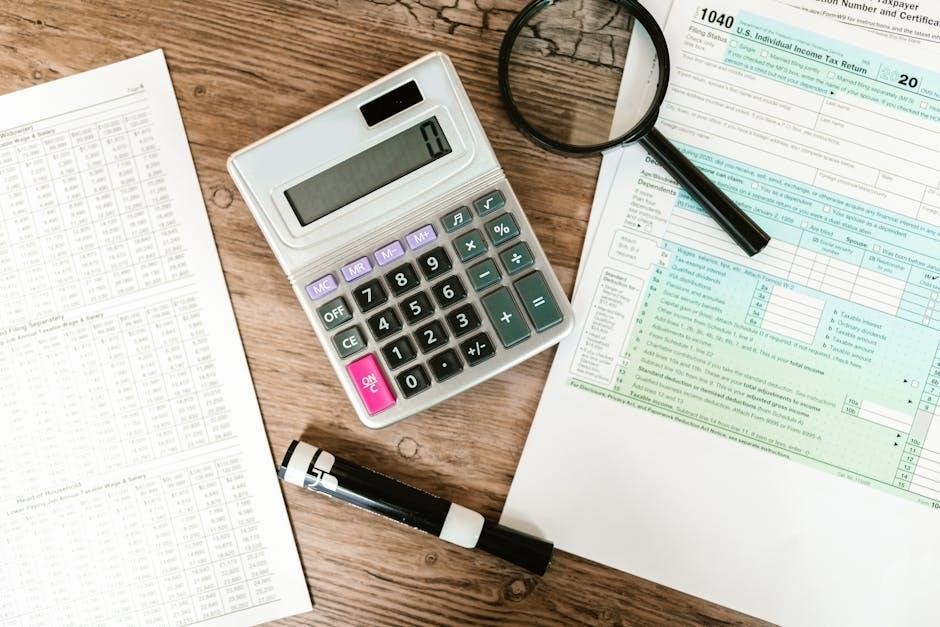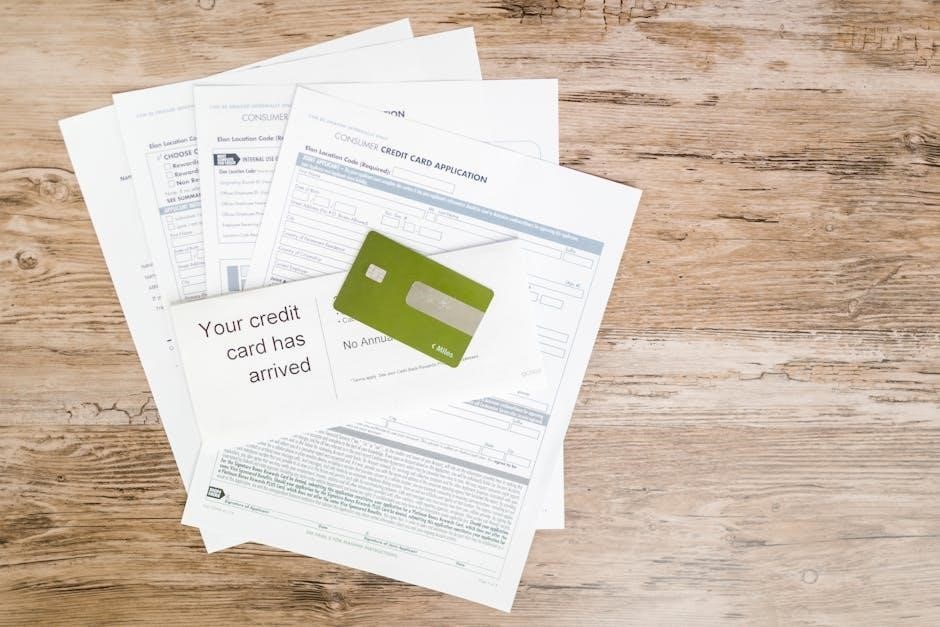A bank account verification letter confirms the existence and details of a bank account, essential for financial transactions, loans, and account openings. Downloadable PDF templates provide a professional format for customization, ensuring security and compliance with banking regulations.
Overview of Bank Account Verification Letters
A bank account verification letter is a formal document provided by a bank to confirm the existence and details of a customer’s account. It serves as proof of account ownership, balance, and transaction capabilities, often required for loans, rentals, or business transactions. The letter typically includes the account holder’s name, account number, balance, and bank official’s signature. Downloadable PDF templates are widely available, offering a professional format that can be customized to meet specific needs while ensuring compliance with banking standards.
Importance of Verification Letters in Financial Transactions
Verification letters are crucial in financial transactions as they provide proof of account ownership and balance, reducing fraud risks. They’re essential for loan applications, account openings, and business deals, ensuring legitimacy. Lenders and landlords rely on these letters to verify credibility. Using official templates ensures compliance and professionalism, facilitating secure and smooth transactions.

Purpose and Importance of Bank Account Verification Letters
A bank account verification letter serves as official proof of account details, ensuring legitimacy and security in financial transactions, loans, and account openings, while preventing fraud.
Why Banks Require Verification Letters
Banks require verification letters to confirm account details, ensuring security and preventing fraud. These documents validate account ownership, balance, and transaction authority, crucial for loan approvals, account openings, and financial transactions; They also help comply with regulatory requirements and protect against fraudulent activities. By verifying account legitimacy, banks minimize risks and ensure smooth, secure processes for all parties involved. Providing false information can lead to legal consequences, making accuracy essential.
Common Scenarios Where Verification Letters Are Needed
Verification letters are often required for loan applications, opening new bank accounts, renting apartments, or conducting significant financial transactions. They are also needed when applying for credit, verifying business account details, or processing international transactions. Additionally, these letters are essential for account ownership confirmation, especially for starter checks without printed business names. They prevent fraud by verifying account legitimacy, ensuring secure and compliant financial processes across various scenarios.

Key Components of a Bank Account Verification Letter
A bank account verification letter must include the bank’s name, logo, account holder’s name, account number, account type, and balance as of a specific date. Signatures or stamps from the bank are also required to validate the document.
Essential Information to Include
A bank account verification letter must include the account holder’s full name, account number, account type (checking or savings), and the current balance as of a specific date. It should also state the account’s status (active or closed) and the bank’s official name, logo, and contact information. The letter should be printed on official bank letterhead and signed by an authorized bank representative, with an official stamp or seal to authenticate the document.
Required Signatures and Stamps
A bank account verification letter must include the signature of an authorized bank representative, typically a branch manager or account officer, to confirm its authenticity. The letter should also feature the bank’s official stamp or seal, which serves as a visual confirmation of its legitimacy. These elements ensure the document is recognized as valid by financial institutions, lenders, or other entities requiring proof of account ownership and details.

Differences Between Personal and Business Account Verification Letters
Personal verification letters focus on individual account holder details and balances, while business letters include company information, authorized signatures, and sometimes financial statements, reflecting distinct requirements for each.
Unique Requirements for Personal Accounts
A personal bank account verification letter must include the account holder’s name, account number, account type, and current balance. It should also specify the account’s opening date and confirm that the account is active. The letter may require the bank’s official stamp or signature to authenticate the details. This document is often used for loan applications, apartment rentals, or other financial transactions requiring proof of funds or account legitimacy.
Additional Details Needed for Business Accounts
A business bank account verification letter requires specific company details, such as the business name, registration number, and address. It must include the account number, type, and opening date, along with the current balance and account status. The letter should also list authorized signatories and may need to confirm the business relationship with the bank. Additional documentation, like a company stamp or authorization from the business owner, may be required to validate the information.

Sample Bank Account Verification Letter
A sample bank account verification letter provides a template to confirm account details, often used for business accounts when checks lack company name imprinting. PDF templates are available for easy customization.
Structure and Format of a Typical Letter
A typical bank account verification letter includes the bank’s header, date, recipient details, account holder’s name, account number, and balance confirmation. It should be printed on official bank letterhead, signed by authorized personnel, and stamped for authenticity. The letter should clearly state the account type, current balance, and any specific transaction details. PDF templates are widely available, offering a professional format that ensures compliance with banking standards and avoids common drafting errors.
Examples of Completed Letters for Reference
Completed bank account verification letters are available as downloadable PDF templates, providing clear examples for reference. These letters typically include the account holder’s name, account number, balance confirmation, and the bank’s official stamp. Templates often feature a professional layout, guiding users on how to present information accurately. Examples may include a formal greeting, detailed account specifics, and a signature section for authentication. These samples help ensure letters are structured correctly and meet banking requirements.
How to Prepare a Bank Account Verification Letter
To prepare a bank account verification letter, include account details, balance confirmation, and the bank’s official stamp. Ensure accuracy and compliance with banking standards for secure transactions.
Step-by-Step Guide to Drafting the Letter
To draft a bank account verification letter, start by including the bank’s letterhead and date. Clearly state the account holder’s name, account number, and type. Confirm the account balance or availability, and specify the purpose of the letter. Ensure the letter is signed by an authorized bank official and stamped for authenticity. Use a professional tone and adhere to the bank’s formatting guidelines. Review the letter for accuracy before submission to avoid delays.
Tips for Ensuring Accuracy and Compliance
Tips for Ensuring Accuracy and Compliance
Ensure accuracy by using official bank templates and including all required details, such as account numbers and balances. Verify the letter’s purpose and recipient to tailor the content appropriately. Obtain proper authorization from account holders before disclosing information. Double-check for errors in names, numbers, and dates. Adhere to banking regulations and include official stamps or signatures for authenticity. Avoid alterations or handwritten changes to maintain professionalism and compliance with financial standards.

Downloading and Using Bank Account Verification Templates
Professional bank account verification letter templates in PDF format are widely available online, offering easy customization. Download from trusted sources like Jurizmo or banking websites, ensuring compliance with financial regulations and saving time on drafting from scratch.
Popular Sources for PDF Templates
Professional bank account verification letter templates in PDF format are available from trusted sources like Jurizmo, Template.net, and banking websites. These platforms offer customizable templates that cater to both individuals and businesses, ensuring compliance with financial regulations. Users can download and print these templates for free or with minimal subscription fees. Popular options include templates from Canara Bank and other financial institutions, designed to streamline the verification process while maintaining security and authenticity.
Customizing Templates for Specific Needs
Templates for bank account verification letters can be tailored to meet individual or business requirements. Users can insert specific details such as account numbers, names, and balances. For businesses, additional information like company names and authorized signatures may be included. Customization ensures the letter aligns with the intended purpose, whether for loan applications, rental agreements, or account openings. Many templates allow for easy editing, enabling users to add or remove sections as needed. This flexibility ensures accuracy and relevance while maintaining professional standards.

Verification Process for Individuals
Individuals must submit required documents to their bank to initiate verification. The bank issues a letter confirming account details, ensuring authenticity and security for financial transactions.
Documents Required for Personal Account Verification
For personal account verification, individuals typically need to provide a valid government-issued ID, recent bank statements, and a signed verification request form. Additional documents like a Residential Verification Form or a notarized affidavit may be required. These documents ensure the account holder’s identity and account details are accurate. The process aims to confirm account ownership securely.
Timeline for Obtaining the Letter
Obtaining a bank account verification letter typically takes 3-5 business days, though some banks may process requests faster. Urgent cases may offer same-day or next-day service. Contacting the bank in advance to confirm processing timelines is recommended. Factors like document completeness and bank workload can affect delays. Ensure all required information is accurate to avoid hold-ups. For personal accounts, processing is generally quicker than for business accounts, which may require additional documentation.
Verification Process for Businesses
The verification process for businesses involves submitting additional documentation, such as EIN, business license, and signed authority documents. Banks may require account statements or specific transaction details. The process ensures compliance with financial regulations and verifies the legitimacy of business operations. Timeline varies, but typically takes 5-7 business days, depending on document complexity and bank procedures. Delays may occur if information is incomplete or requires further verification.
Additional Documentation for Business Accounts
Businesses must provide an Employer Identification Number (EIN), business license, and articles of incorporation. Signed authority documents, such as board resolutions, are often required to confirm account signers. Proof of business address and ownership, like a trade license, may also be needed. Banks may request financial statements or recent tax returns to validate the business’s operational status. Providing accurate and complete documentation ensures the verification process proceeds smoothly and avoids delays.
Special Considerations for Corporate Accounts
Corporate accounts often require additional documentation, such as board resolutions and specimen signature cards, to confirm the authority of signatories. These documents ensure that all transactions are authorized and legitimate. Corporations may also need to provide updated financial statements or tax returns to validate their operational status and creditworthiness. Specific banking regulations and institutional requirements may apply, making it essential to verify details with the bank to ensure compliance and avoid delays in the verification process.

Alternative Methods of Account Verification
Beyond verification letters, methods like online banking portals, mobile app verification, or submitting official bank statements can confirm account details securely and efficiently for various financial needs.
Using Bank Statements or Check Details
Bank statements and check details serve as alternative verification methods. Statements provide a detailed record of account activity, balances, and transaction history, while checks often include account numbers and holder information. These documents can be submitted to verify account ownership, especially when a verification letter is unavailable. They are widely accepted by financial institutions, employers, and landlords as proof of account legitimacy and can be used for loan applications, account openings, or rental agreements. This method is both efficient and reliable for confirming account details without requiring a formal letter from the bank.
Electronic Verification Forms and Processes
Electronic verification forms and processes offer a streamlined alternative to traditional letters. Many banks provide online platforms where customers can generate verification letters instantly. Digital signatures and secure authentication methods ensure the documents’ legitimacy. These processes reduce paperwork and expedite financial transactions, making them ideal for modern banking needs. Additionally, electronic verification minimizes errors and ensures compliance with regulatory requirements, providing a faster and more efficient way to confirm account details.

Legal and Compliance Considerations
Bank account verification letters must comply with legal regulations, adhering to strict standards to ensure authenticity and accuracy, avoiding penalties and ensuring financial integrity and security.
Regulatory Requirements for Verification Letters
Bank account verification letters must comply with regulatory standards to prevent fraud and ensure accuracy. They should include specific details like account holder’s name, account number, and balance. Official templates help meet legal requirements, while incorrect or incomplete information can lead to penalties. Compliance ensures secure financial transactions and maintains trust in banking processes. Adhering to these standards is crucial for both individuals and businesses to avoid legal consequences.
Consequences of Providing False Information
Providing false information in a bank account verification letter can lead to severe legal consequences, including penalties and fines. It may result in the suspension or closure of your bank account and damage to your credit score. Misrepresentation of facts can also lead to criminal charges for fraud, affecting your financial reputation and future transactions. It is essential to ensure all details are accurate to avoid these repercussions and maintain trust with financial institutions.

Common Mistakes to Avoid
Typographical errors, missing signatures, and outdated information are common mistakes. Ensure all details match your bank records and avoid using unverified templates to maintain accuracy.
Errors That Could Delay Verification
Typographical errors, incorrect account numbers, and missing signatures are common issues that can delay verification. Ensure all details match your bank records and avoid using outdated templates. Missing official bank stamps or incorrect formatting can also lead to rejection. Double-checking the letter for accuracy before submission is crucial to avoid delays. Using unverified templates or omitting key information, such as account balances or dates, can further complicate the process and require resubmission.
Best Practices for Submitting Letters
Always use verified templates from trusted sources to ensure compliance with banking standards. Double-check all details, including account numbers and balances, before submission. Include official bank stamps and signatures to authenticate the document. Submit the letter well in advance of deadlines to avoid delays. Ensure the letter is customized to meet the specific requirements of the recipient. Use secure delivery methods to prevent tampering or loss. Verify the recipient’s guidelines to ensure proper formatting and content; This ensures a smooth verification process and avoids unnecessary rejections or delays.
A bank account verification letter is crucial for validating account details, ensuring secure financial transactions, and meeting regulatory requirements. Using professional PDF templates simplifies the process, ensuring accuracy and compliance with banking standards. This document plays a vital role in various financial activities, providing confidence to all parties involved.
Final Thoughts on the Importance of Verification Letters
A bank account verification letter is a critical document for confirming account details, ensuring secure financial transactions, and meeting regulatory requirements. Its importance lies in preventing fraud, verifying account ownership, and facilitating smooth financial processes. By using professional PDF templates, individuals and businesses can ensure accuracy and compliance with banking standards, making it an essential tool for various financial activities.
Next Steps After Obtaining the Letter
After obtaining the bank account verification letter, submit it to the requesting institution or organization. Ensure all details are accurate and meet the required standards. Follow up to confirm receipt and acceptance. Store a copy for your records and use it for future financial transactions. This letter simplifies processes like loan applications, account openings, or rental agreements, ensuring compliance and security in your financial dealings.